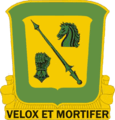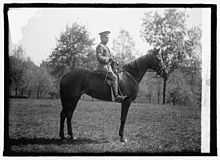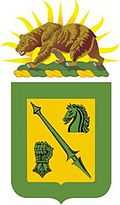18th Cavalry Regiment
| 18th Cavalry Regiment | |
|---|---|
|
Coat of arms | |
| Active | 1885-present |
| Country | United States of America |
| Branch | United States Army |
| Type | Cavalry |
| Role | RSTA |
| Size | Squadron |
| Garrison/HQ | Azusa, California (HHT) |
| Motto | Velox et Mortifer (Swift and Deadly)[1] |
| Engagements |
|
| Decorations |
Philippine Presidential Unit Citation[2] Republic of Korea Presidential Unit Citation[2] Meritorious Unit Commendation[3][4] |
| Insignia | |
| Distinctive unit insignia |
 |
| U.S. Cavalry Regiments | |
|---|---|
| Previous | Next |
| 17th Cavalry Regiment | 26th Cavalry Regiment |
The 18th Cavalry Regiment is a cavalry regiment of the United States Army
The 1st Squadron, 18th Cavalry Regiment, is the reconnaissance element of the 79th Infantry Brigade Combat Team of the California Army National Guard. Prior to the most recent reorganization of the United States Army National Guard the unit was an aviation unit. It was equipped with AH-1F Cobras,[5] and formed part of the 40th Infantry Division's Aviation Brigade.
History
The 1st Squadron, 18th Cavalry Regiment, was constituted on 22 July 1885 in the California National Guard as the 7th Infantry Battalion and organized from existing companies in southern California. It expanded, reorganized, and was redesignated on 5 May 1888 as the 7th Infantry Regiment.
The unit consolidated on 7 December 1895 with the 9th Infantry Regiment (organized on 8 February 1890 in the California National Guard) and consolidated unit designated as the 7th Infantry Regiment. It mustered into federal service on 9 May 1898 at the Presidio of San Francisco as the 7th California Volunteer Infantry; and mustered out of federal service on 2 December 1898 at Los Angeles. It mustered into federal service on 29 June 1916 at Sacramento; and mustered out of federal service on 11 November 1916 at Los Angeles. It was drafted into federal service on 5 August 1917.

It consolidated on 25 September-1 November 1917 with the 2nd Battalion, Companies L and M, and the Sanitary Detachment, 2nd Infantry Regiment; the consolidated unit reorganized and was redesignated as the 160th Infantry and assigned to the 40th Division. It demobilized on 7 May 1919 at Camp Kearny in San Diego.
Former southern California elements reorganized on 23 August-6 October 1921 in the California National Guard as the 160th Infantry and was assigned to the 40th Division; Headquarters was federally recognized on 31 January 1922 at Los Angeles.
The 2nd Battalion 160th Infantry, reorganized and was redesignated on 1 April 1929 as the 2nd Battalion, 185th Infantry, an element of the 40th Division (160th Infantry — hereafter separate lineage). It expanded, reorganized, and was redesignated in March–April 1930 as the 2nd and 3rd Battalions, 185th Infantry, elements of the 40th Division (later designated as the 40th Infantry Division). It was inducted into federal service on 3 March 1941 at home stations. It inactivated on 7 April 1946 at Camp Stoneman, CA.
The 2nd Battalion, 185th Infantry, was redesignated on 5 August 1946 as the 223rd Infantry and remained assigned to the 40th Infantry Division (the 3rd Battalion, 185th Infantry, was concurrently redesignated as the 224th Infantry — hereafter separate lineage). The 223rd Infantry was organized and federally recognized on 15 October 1946 with Headquarters at Pasadena Ordered into active federal service on 1 September 1950 at home stations (the 223rd Infantry [NGUS] organized and was federally recognized on 2 September 1952 with Headquarters at Pasadena). The unit was released on 30 June 1954 from active federal service and reverted to state control; Federal recognition was concurrently withdrawn from the 223rd Infantry (NGUS).
The 2nd Battalion, 223rd Infantry, consolidated with the 3rd Battalion, 111th Armored Cavalry (organized and federally recognized on 26 January 1951 with Headquarters at Van Nuys [changed on 1 November 1951 to Burbank]); and the consolidated unit was concurrently reorganized and redesignated as the 139th Tank Battalion, with Headquarters at Burbank, and assigned to the 40th Armored Division (223rd Infantry — hereafter separate lineage).
The 139th Tank Battalion reorganized and was redesignated on 1 July 1959 as the 2nd Medium Tank Battalion, 185th Armor, an element of the 40th Armored Division.
The unit reorganized and was redesignated on 1 March 1963 as the 1st Reconnaissance Squadron, 18th Armored Cavalry, and relieved from assignment to the 40th Armored Division. It was reorganized and redesignated on 1 November 1965 as the 1st Squadron, 18th Armored Cavalry; and ordered into active federal service on 13 May 1968 at home stations; before being released on 12 December 1969 from active federal service and reverting to state control.[6]
It was reorganized and redesignated on 13 January 1974 as the 18th Cavalry, a parent regiment under the Combat Arms Regimental System, to consist of the 1st Squadron, an element of the 40th Infantry Division. It was withdrawn on 19 January 1988 from the Combat Arms Regimental System and reorganized under the United States Army Regimental System.
The 1st Squadron [less Troops C and D] was ordered into active federal service on 1 May 1992 at home station and deployed to the LA Riots. 1st/18th was first unit on the ground to secure the LA Coliseum, (on the ground for two weeks) released on 9 May 1992 and reverted to state control.
21st century activations and deployments
In the 2003-2004 time period the unit was activated in support of Operation Noble Eagle. This was followed by a 14-month activation to provide a security force for Camp Delta which fell under the GWOT Campaign.[7] During the 2007 California Wildfires approximately 400 soldiers were activated by the Governor of California to assist local authorities in various functions.[8][9][10] 1-18th Cavalry was called to active federal service along with the 79th IBCT in October 2008 in support of NATO peacekeeping efforts in Kosovo. 1-18th Cavalry subsequently returned to the U.S. in November 2009.[11]
Distinctive unit insignia
- Description
A Gold color metal and enamel device 1 1⁄8 inches (2.9 cm) in height overall consisting of a shield blazoned: Or, a tilting spear in bend Vert, between a horse’s head couped and a gauntlet of the like, all within a bordure of the second. Attached below the shield is a Gold scroll inscribed “VELOX ET MORTIFER” in Black letters.
- Symbolism
The shield of the coat of arms for the 111th Armored Cavalry Regiment, differenced by a green border, indicates descent of the 139th Tank Battalion from the 3d Battalion of that organization. The colors yellow and green are used for Armor. The horse’s head and lance symbolize Cavalry and medieval armor, respectively. The gauntlet represents the shock action of armor and the ability to deliver a decisive blow.
- Background
The distinctive unit insignia was originally approved for the 139th Tank Battalion on 28 February 1956. It was redesignated for the 18th Armored Cavalry Regiment on 24 April 1968. The insignia was redesignated for the 18th Cavalry Regiment on 13 May 1975.
Coat of arms
Blazon
- Crest
Or, a tilting spear in bend Vert, between a horse’s head couped and a gauntlet of the like, all within a bordure of the second.
- Shield
That for the regiments and separate battalions of the California Army National Guard: On a wreath of the colors Or and Vert, the setting sun behind a grizzly bear passant on a grassy field all Proper. Motto VELOX ET MORTIFER (Swift and Deadly).
Symbolism
- Shield
The shield of the coat of arms for the 111th Armored Cavalry Regiment, differenced by a green border, indicates descent of the 139th Tank Battalion from the 3d Battalion of that organization. The colors yellow and green are used for Armor. The horse’s head and lance symbolize Cavalry and medieval armor, respectively. The gauntlet represents the shock action of armor and the ability to deliver a decisive blow.
- Crest
The crest is that of the California Army National Guard.
Background
The coat of arms was originally approved for the 139th Tank Battalion on 28 February 1956. It was redesignated for the 18th Armored Cavalry Regiment on 24 April 1968. The insignia was redesignated for the 18th Cavalry Regiment on 13 May 1975.
References
- ↑ Barry Jason Stein (1993). U.S. Army Heraldic Crests: A Complete Illustrated History of Authorized Distinctive Unit Insignia. Univ of South Carolina Press. p. 87. ISBN 978-0-87249-963-8.
- ↑ 2.0 2.1 "18th Cavalry Regiment". Lineages and Honors of the California National Guard. The California State Military Museum. Retrieved 21 October 2012.
- ↑ "The War on Terrorism: Unit Award Orders & Citations". United States Army Center of Military History. United States Army. 20 July 2012. Retrieved 22 October 2012.
- ↑ Brandon Honig. "Year in Review 2010". Grizzly Magazine. California National Guard. Retrieved 22 October 2012.
After more than four years, 1st Squadron, 18th Cavalry Regiment, was recognized with a Meritorious Unit Commendation for exceptional performance of its security operations mission in Guantanamo Bay, Cuva in 2005 and 2006.
- ↑ "Army National Guard Units". 21st Cavalry Brigarde. United States Army. 20 April 2012. Retrieved 22 October 2012.
- ↑ Robinson, Douglas (26 September 1968). "Allies Repel Fierce Attack on Camp Near Tayninh". Saigon: The New York Times. Retrieved 2009-05-12.
The squadron, the First Squadron of the 18th Cavalry Regiment, is now stationed at Fort Lewis, Wash.
- ↑ ERIKA I. RITCHIE (2006-04-03). "Bittersweet homecoming for one National Guardsmen". OC Register. Orange County Register Communications. Archived from the original on 2009-05-14. Retrieved 2009-05-12.
- ↑ "CNG Soldiers Activate to Support Local Authorities During Wildfire". 69th Public Affairs Detachment. 2007-10-26. Archived from the original on 2009-05-14. Retrieved 2009-05-12.
- ↑ State of California (2007-10-25). "Press Release 10-17". California National Guard. State of California. Archived from the original on 2009-05-14. Retrieved 2009-05-12.
- ↑ "More than 1,450 guardsmen called up in Calif.". Army Times. Army Times Publishing Company. 2007-10-25. Retrieved 2009-05-12.
- ↑ Robinson, Douglas (26 September 1968). "Departure Ceremony for Kosovo Forces". California: News Blaze. Archived from the original on 2009-09-12. Retrieved 2009-05-12.
Departure Ceremony for Kosovo Forces
![]() This article incorporates public domain material from the United States Army Institute of Heraldry document "118th Cavalry Regiment".
This article incorporates public domain material from the United States Army Institute of Heraldry document "118th Cavalry Regiment".
